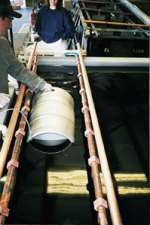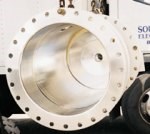Electropolishing: A Chemical Alternative
Southeastern Electro-Polishing uses chemicals rather than manual buffing and polishing equipment to achieve a polished finish on stainless steel. What are the advantages of this process?
Southeastern Electro-Polishing, Lake Monroe, FL, looks like many other finishing shops nestled in industrial parks across the country. But when you find out exactly what the company does, you realize just how important this little electropolishing shop is to the marine, pharmaceutical, semi-conductor, food and medical industries.
"We specialize in electropolishing," stated Scott Lees, plant manager. "It is all we do. This way we feel we can offer our customers the best because it is not just another service we offer, it is all we do." Fifty percent of the company's business is with the marine industry.
Featured Content
This was the goal when Southeastern Electro-Polishing opened nine years ago—to be the number one electropolishing shop. And owner Jimmy Costello knew that to achieve his goal he had to focus on electropolishing, nothing else. That is exactly what the company has done. The company electropolishes .50-cm springs for heart valves as well as doing in-situ electropolishing of large vessels having 10-ft diameters and standing 12-14 ft high.
According to Mr. Lees, electropolishing can replace numerous production and finishing steps, saving money and enhancing the finished product. Electropolishing removes the impurities on the metal surface and eliminates them throughout the metal. This may include oxidation from welding or other discoloration from other processing; however, the main contaminant is carbon. Although stainless steel does not contain much carbon, the electropolishing process pulls out much of what is there, rendering a more pure product. In addition, the surface is resealed, eliminating any microscopic pits or pores. As a bonus, the hydrogen is virtually removed, making the metal sanitized, which is beneficial for the food, medical and pharmaceutical industries since hydrogen allows anaerobic bacteria to breed. Without the pores or pits, elements cannot enter the surface to allow for bacterial growth or rusting.
When considering applications for food and beverage processing, additional factors arise. The provisions of statutory regulations have to be met and a salient feature is that all materials used for food and beverage use shall not endanger human health or bring about a deterioration in organoleptic (affecting the organs of the senses) characteristics of the food or beverage or an unacceptable change of its nature, substance and quality. "This has been partly responsible for the microbrewing industry adopting stainless steel extensively for dispensing equipment instead of the traditional copper alloys," Mr. Lees added.
What is Electropolishing?
Electropolishing smoothes a metal surface anodically in a concentrated acid or alkaline solution. With the application of current, a film forms on the metal surface, allowing metal ions to diffuse through the film. The high points of the surface and burr areas are areas of higher current density. These areas are dissolved at a greater rate than the remainder of the surface. The result is a smoother, more uniform surface.
Southeastern electropolishes mostly 300-series stainless steel, although it does not shy away from 400-series. Stainless steel and electropolishing are an ideal pair. As expected of stainless steel, its lustrous appearance is retained unblemished under conditions of exposure that would quickly tarnish, rust or corrode other metals. The electropolished surface of stainless is more inert and corrosion resistant than other treatments, such as nitric acid, pickling and mechanical polishing.
Using chemical or physical processes to remove all surface contamination prior to electropolishing is essential to maintain a good appearance and eliminate localized corrosion. Parts are first electrocleaned prior to electropolishing. If the parts have been marked for identification with marker or paint, which they often are, this must be removed as well. This can be done mechanically uses grinders or buffers or by hand using solvent solution and wipers.
Mr. Lees noted that there are several advantages to electropolishing:
Destressing: Springs and small stampings subjected to thousands or millions of cycles fail prematurely due to metal fatigue. By removing surface metal, electropolishing actually helps solve metal fatigue problems caused by surface cracks, nicks, scratches and fabrication stresses. The process removes the surface skin and stresses and reduces or eliminates stress risers (imperfections) caused by heat treating, decarburization, microscopic scratches, tool marks and grinding checks. This increases the part's cycle life while imparting a smooth, bright, deburred surface.
Purification: As mentioned previously, electropolishing restricts bacteria growth by removing hydrogen throughout the metal. Unlike a coating, an electropolished surface cannot flake off or chip, which is important for food or pharmaceutical processing, high vacuum assemblies and pure gas/water systems, such as reverse osmosis.
Sizing: Southeastern Electro-Polishing can control the removal of the surface metal to within 0.0001 inch. This control combined with its ability to process work on complex and fragile components has opened new applications in part sizing. Oversize and overweight parts can be returned to original specifications within close tolerances, eliminating secondary machining operations.
"For example," explained Mr. Lees, "say you have parts made oversize by an operator or machine error, you can use electropolishing to bring it back down to size. Secondary machining an oversized part is often not practical once it is finished or hardened. Electropolishing can be done no matter how hard the part is and no matter what the part's geometry is."
Adhesion: Electropolishing improves the adhesion of paint, adhesives or plasma. Oxides, oil, corrosion and organic debris on the metal surface make adhesion difficult. After electropolishing, the bonding ability during welding or soldering is improved greatly, since outgassing is restricted once impurities are removed. Welding is faster and can be done with lower temperatures.
Deburring: Electropolishing is excellent for deburring, especially large, complex or fragile parts that do not lend themselves to conventional tumbling or vibratory techniques. During electropolishing, electrochemical power is concentrated at high points, leveling sharp edges, ridges and burrs. Because it is a controlled process, there is minimal change in part dimensions. The process works equally well on finished parts that have been annealed or hardened.
Surface Finishing: A poor microfinish can cause problems such as frictional resistance, leaking in critical assemblies and premature wear on related components. Electropolishing can correct these problems while leaving part dimensions within tolerance. The high spots are attacked more rapidly to create a smoother, brighter surface. Simultaneously, all impurities such as scale, rust, debris, oils, grinding compounds and other materials are removed as the surface material is dissolved.
Electropolishing improves sealing surfaces for valves, fittings, gaskets and bearings. Cosmetic parts for decorative purposes such as automotive and appliance accessories also benefit, since the process produces a mirror finish on stainless steel that resembles a chromium plated finish.
Southeastern Electro-Polishing adds even more to its electropolishing processes. It adds customer service, attention to detail and it specializes in difficult jobs, such as large vessels and minute parts. "We work with every customer to make sure they understand the process and to make sure we can give them exactly what they are looking for," stated Mr. Lees.
For example, most customers do not want load marks from the racks or fixturing hooks left on the parts after processing. Southeastern works with the customers to determine where the parts can be fixtured so as not leave a load mark or to find a suitable area where one may be tolerated. However, it isn't that simple. Parts also must be hung level and in a position so that they drain properly. Also, the cathodes cannot touch the part or the walls of the tanks, since this could cause arcing and possibly "blow a hole" in the part.
Many parts require specially built cathodes, particularly the vessels that are plated in-situ. Building a cathode can take anywhere from an hour to more than a day, depending on the size of the vessel or the intricacy of the part. "The entire electropolishing process is actually more of an art form than a science," commented Mr. Lees. Southeastern mixes its own cleaners, electropolishing solutions and finishing chemistries. Parts follow a standard process of electroclean; several rinses; electropolish; rinses; a hot water rinse; Type II passivate, which helps remove any acid residue that may be left over from the electropolishing process; cold water rinse; and a final hot water rinse. Parts are then shipped to quality control for inspection.
Southeastern has five electropolishing lines designed to accommodate the variety of parts it finishes. Its largest line features 24-ft long tanks that are 5-ft wide and 5-ft deep. Other lines have tanks with the same width and depth, but lengths include 21, 8, 6 and 3 ft. Southeastern Electro-Polishing is set up to be the biggest little electropolishing shop in the Southeastern United States. It knows electropolishing. It focuses on electropolishing. It has built its shop to accommodate any shape or size part that a customer brings through its doors. "We concentrate on electropolishing because we want to be the best at it," stated Mr. Lees. "When people think of electropolishing, we want them to think of Southeastern Electro-Polishing."





















